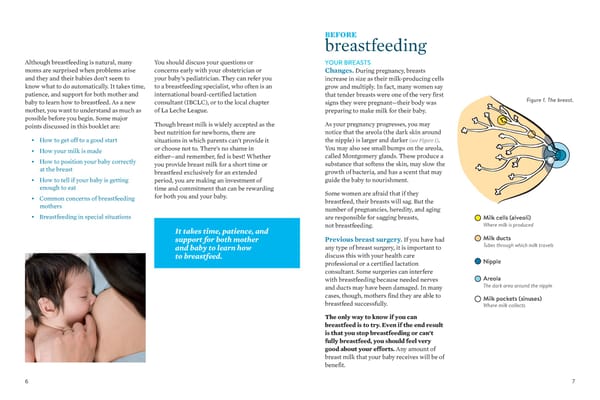BEFORE breastfeeding Although breastfeeding is natural, many You should discuss your questions or YOUR BREASTS moms are surprised when problems arise concerns early with your obstetrician or Changes. During pregnancy, breasts and they and their babies don’t seem to your baby’s pediatrician. They can refer you increase in size as their milk-producing cells know what to do automatically. It takes time, to a breastfeeding specialist, who often is an grow and multiply. In fact, many women say patience, and support for both mother and international board-certified lactation that tender breasts were one of the very first baby to learn how to breastfeed. As a new consultant (IBCLC), or to the local chapter signs they were pregnant—their body was Figure 1. The breast. mother, you want to understand as much as of La Leche League. preparing to make milk for their baby. possible before you begin. Some major Though breast milk is widely accepted as the As your pregnancy progresses, you may points discussed in this booklet are: best nutrition for newborns, there are notice that the areola (the dark skin around • How to get off to a good start situations in which parents can’t provide it the nipple) is larger and darker (see Figure 1). • How your milk is made or choose not to. There’s no shame in You may also see small bumps on the areola, • H ow to position your baby correctly either—and remember, fed is best! Whether called Montgomery glands. These produce a at the breast you provide breast milk for a short time or substance that softens the skin, may slow the breastfeed exclusively for an extended growth of bacteria, and has a scent that may • H ow to tell if your baby is getting period, you are making an investment of guide the baby to nourishment. enough to eat time and commitment that can be rewarding Some women are afraid that if they • Common concerns of br eastfeeding for both you and your baby. breastfeed, their breasts will sag. But the mothers number of pregnancies, heredity, and aging • Breastfeeding in special situations are responsible for sagging breasts, Milk cells (alveoli) It takes time, patience, and not breastfeeding. Where milk is produced support for both mother Previous breast surgery. If you have had Milk ducts and baby to learn how any type of breast surgery, it is important to Tubes through which milk travels to breastfeed. discuss this with your health care Nipple professional or a certified lactation consultant. Some surgeries can interfere with breastfeeding because needed nerves Areola and ducts may have been damaged. In many The dark area around the nipple cases, though, mothers find they are able to Milk pockets (sinuses) breastfeed successfully. Where milk collects The only way to know if you can breastfeed is to try. Even if the end result is that you stop breastfeeding or can’t fully breastfeed, you should feel very good about your efforts. Any amount of breast milk that your baby receives will be of benefit. 6 7
 Breastfeeding Guide Page 3 Page 5
Breastfeeding Guide Page 3 Page 5